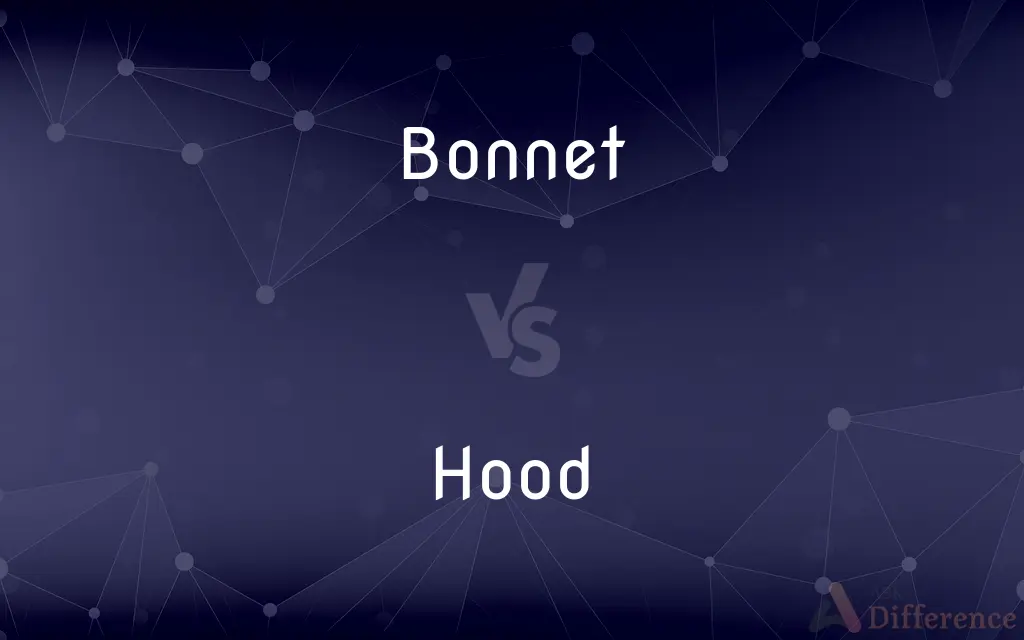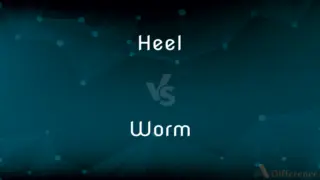Bonnet vs. Hood — What's the Difference?
By Tayyaba Rehman & Urooj Arif — Updated on April 3, 2024
The bonnet covers the engine compartment in British English, while the hood serves the same purpose in American English.

Difference Between Bonnet and Hood
Table of Contents
ADVERTISEMENT
Key Differences
The terms "bonnet" and "hood" both refer to the protective cover over a vehicle's engine compartment, differing primarily by regional language use; "bonnet" is used in British English, whereas "hood" is the term in American English. This distinction highlights the influence of regional dialects on automotive terminology.
While both serve the same functional purpose of providing access to the engine for maintenance and repair, the term used can indicate the speaker's nationality or the origin of the vehicle. For instance, an American might refer to opening the hood to check the oil, while a Briton would say they're opening the bonnet for the same task.
The choice of word can also reflect broader linguistic differences between British and American English, extending beyond automotive terms to clothing, where "bonnet" in British English historically refers to a type of hat, contrasting with its purely automotive use in American English.
Understanding the difference between "bonnet" and "hood" is not just about automotive parts but also offers insight into the nuances of English language use across different regions. It showcases how language adapts and diverges, reflecting cultural and regional identities even in the context of global technologies like automobiles.
Comparison Chart
Regional Use
Predominantly British English
Predominantly American English
ADVERTISEMENT
Functional Purpose
Covers engine compartment
Covers engine compartment
Related Terms
Associated with both cars and traditional women’s hats in the UK
Strictly automotive in the US; also refers to a type of headwear
Linguistic Context
Reflects broader British English terminology
Reflects broader American English terminology
Cultural Insight
Indicates the speaker's nationality or vehicle's origin
Showcases linguistic divergence in English
Compare with Definitions
Bonnet
A covering over the engine compartment of a car, primarily in British English.
She opened the bonnet to check the engine oil.
Hood
A covering over the engine compartment of a car, primarily in American English.
He popped the hood to jump-start the car.
Bonnet
Historically, a type of hat tied under the chin, common in older British English.
In historical dramas, women often wear bonnets.
Hood
A type of headgear that covers the head, often part of a larger garment.
She wore a hood to protect herself from the rain.
Bonnet
In certain contexts, can refer to parts of machinery that cover or protect.
The technician removed the bonnet to repair the machinery.
Hood
The upper opening of a garment, designed to cover the head.
His sweatshirt's hood was drawn tight against the cold.
Bonnet
A protective covering or lid.
The chef used a bonnet to cover the dish before serving.
Hood
Used metaphorically to suggest covering or concealing, similar to "bonnet" in some contexts.
The company is keeping the details of the new product under the hood.
Bonnet
Also used in slang or metaphorically to refer to something that covers or conceals.
He lifted the bonnet on the company's secret project.
Hood
In certain areas, "hood" colloquially refers to a neighborhood, especially in urban contexts.
He's well-known in his hood for his community work.
Bonnet
A woman's or child's hat tied under the chin and with a brim framing the face.
Hood
A covering for the head and neck with an opening for the face, typically forming part of a coat or cloak
A jacket with a detachable hood
Bonnet
The hinged metal canopy covering the engine of a motor vehicle.
Hood
A thing resembling a hood in shape or use.
Bonnet
A cowl on a chimney.
Hood
A gangster or similar violent criminal
I been beaten up by hoods
Bonnet
An additional canvas laced to the foot of a sail to catch more wind.
Hood
A neighbourhood, especially one in an urban area
I've lived in the hood for 15 years
Bonnet
A hat of cloth or straw, often held in place by ribbons tied under the chin and traditionally worn by women and children.
Hood
Put a hood on or over
She was forced into a car, hooded, and taken to a cell
Bonnet
(Scots) A brimless cap traditionally worn by men or boys.
Hood
A loose pliable covering for the head and neck, often attached to a robe or jacket.
Bonnet
A removable metal plate over a machine part, such as a valve.
Hood
An ornamental draping of cloth hung from the shoulders of an academic or ecclesiastical robe.
Bonnet
Chiefly British The hood of an automobile.
Hood
A sack placed over the head of a falcon to keep it quiet.
Bonnet
A windscreen for a chimney.
Hood
A metal cover or cowl for a hearth or stove.
Bonnet
A cover for a fireplace.
Hood
A carriage top.
Bonnet
(Nautical) A strip of canvas laced to a fore-and-aft sail to increase sail area.
Hood
The hinged metal lid over the engine of a motor vehicle.
Bonnet
To put a bonnet on.
Hood
(Zoology) A colored marking or an expanded part, such as a crest, on or near the head of an animal.
Bonnet
A type of hat, once worn by women or children, held in place by ribbons tied under the chin.
Hood
A hoodlum; a thug.
Bonnet
A traditional Scottish woollen brimless cap; a bunnet.
Hood
A rowdy or violent young person.
Bonnet
(by extension) The polishing head of a power buffer, often made of wool.
Hood
A neighborhood, usually in the inner city.
Bonnet
The hinged cover over the engine of a motor car; a hood.
Hood
Variant of hood3.
Bonnet
(nautical) A length of canvas attached to a fore-and-aft sail to increase the pulling power.
Hood
To supply or cover with a hood.
Bonnet
An accomplice of a gambler, auctioneer, etc., who entices others to bet or to bid.
Hood
A covering for the head attached to a larger garment such as a jacket or cloak.
Bonnet
The second stomach of a ruminant.
Hood
A distinctively coloured fold of material, representing a university degree.
Bonnet
(historical) A ducat, an old Scottish coin worth 40 shillings.
Hood
An enclosure that protects something, especially from above.
Bonnet
Anything resembling a bonnet (hat) in shape or use.
Hood
Particular parts of conveyances
Bonnet
A small defence work at a salient angle; or a part of a parapet elevated to screen the other part from enfilade fire.
Hood
A soft top of a convertible car or carriage.
Bonnet
A metallic canopy, or projection, over an opening, as a fireplace, or a cowl or hood to increase the draught of a chimney, etc.
Hood
The hinged cover over the engine of a motor vehicle, known as a bonnet in other countries.
Bonnet
A frame of wire netting over a locomotive chimney, to prevent escape of sparks.
Hood
A cover over the engine, driving machinery or inner workings of something.
Bonnet
A roofing over the cage of a mine, to protect its occupants from objects falling down the shaft.
Hood
A metal covering that leads to a vent to suck away smoke or fumes.
Bonnet
In pumps, a metal covering for the openings in the valve chambers.
Hood
(nautical) One of the endmost planks (or, one of the ends of the planks) in a ship’s bottom at bow or stern, that fits into the rabbet. These, when fit into the rabbet, resemble a hood (covering).
Bonnet
(mycology) A mushroom of the genus Mycena.
Hood
Various body parts
Bonnet
(transitive) To put a bonnet on.
Hood
(ophiology) An expansion on the sides of the neck typical for many elapids e.g. the Egyptian cobra (Naja haje) and Indian cobra (Naja naja).
Bonnet
(obsolete) To take off the bonnet or cap as a mark of respect; to uncover.
Hood
(colloquial) The osseous or cartilaginous marginal extension behind the back of many a dinosaur such as a ceratopsid and reptiles such as Chlamydosaurus kingii.
Bonnet
To pull the bonnet or cap down over the eyes of.
Hood
In the human hand, over the extensor digitorum, an expansion of the extensor tendon over the metacarpophalangeal joint (the extensor hood syn. dorsal hood syn. lateral hood)
Bonnet
A headdress for men and boys; a cap.
Hood
(slang) Gangster, thug.
Bonnet
A soft, elastic, very durable cap, made of thick, seamless woolen stuff, and worn by men in Scotland.
And p i s and bonnets waving high.
Hood
Neighborhood.
What’s goin’ down in the hood?
Bonnet
A covering for the head, worn by women, usually protecting more or less the back and sides of the head, but no part of the forehead. The shape of the bonnet varies greatly at different times; formerly the front part projected, and spread outward, like the mouth of a funnel.
Hood
(UK) Person wearing a hoodie.
Bonnet
Anything resembling a bonnet in shape or use
Hood
To cover something with a hood.
Bonnet
An additional piece of canvas laced to the foot of a jib or foresail in moderate winds.
Hood
Relating to inner-city everyday life, both positive and negative aspects; especially people’s attachment to and love for their neighborhoods.
Bonnet
The second stomach of a ruminating animal.
Hood
State; condition.
How could thou ween, through that disguised hoodTo hide thy state from being understood?
Bonnet
An accomplice of a gambler, auctioneer, etc., who entices others to bet or to bid; a decoy.
Hood
A covering or garment for the head or the head and shoulders, often attached to the body garment
Bonnet
The metal cover or shield over the motor; predominantly British usage. In the U.S. it is called the hood.
Hood
Anything resembling a hood in form or use
Bonnet
To take off the bonnet or cap as a mark of respect; to uncover.
Hood
The endmost plank of a strake which reaches the stem or stern.
Bonnet
A hat tied under the chin
Hood
Same as hoodlum.
Bonnet
Protective covering consisting of a metal part that covers the engine;
There are powerful engines under the hoods of new cars
The mechanic removed the cowling in order to repair the plane's engine
Hood
Same as neighborhood.
Bonnet
Dress in a bonnet
Hood
To cover with a hood; to furnish with a hood or hood-shaped appendage.
The friar hooded, and the monarch crowned.
Hood
To cover; to hide; to blind.
While grace is saying, I'll hood mine eyesThus with my hat, and sigh and say, "Amen."
Hood
An aggressive and violent young criminal
Hood
Metal covering leading to a vent that exhausts smoke or fumes
Hood
The folding roof of a carriage
Hood
A headdress that protects the head and face
Hood
Protective covering consisting of a metal part that covers the engine;
There are powerful engines under the hoods of new cars
The mechanic removed the cowling in order to repair the plane's engine
Hood
Cover with a hood;
The bandits were hooded
Common Curiosities
What does "hood" mean outside of automotive context?
Outside of an automotive context, "hood" can refer to a type of headgear that covers the head, the upper opening of a garment designed to cover the head, or colloquially, a neighborhood, especially in urban areas.
Is the function of a car's bonnet different in the UK compared to the hood in the US?
No, the function of a car's bonnet in the UK and the hood in the US is identical; both terms describe the cover that protects the engine compartment.
Can the word "bonnet" refer to anything other than a car part in British English?
Yes, historically, "bonnet" in British English also refers to a type of hat worn by women, tied under the chin.
Are bonnets and hoods the same thing in cars?
Yes, bonnets and hoods refer to the same part of a car but are termed differently in British and American English, respectively.
What is a bonnet in automotive terms?
In automotive terms, a bonnet is the cover over the engine compartment of a car, used primarily in British English.
Are there safety features associated with bonnets and hoods?
Yes, modern cars often include safety features like hood latches that prevent accidental opening while driving and crumple zones designed to absorb impact in a collision.
What should you do if your car's bonnet or hood won't close?
If your car's bonnet or hood won't close, check for obstructions or misalignments. If the issue isn't easily resolved, seek professional assistance to avoid safety hazards.
What does the hood of a car do?
The hood of a car covers the engine compartment, providing access for maintenance and repair, used in American English.
Why do British and American English use different terms for the car engine cover?
British and American English developed unique vocabularies over time due to cultural, historical, and social influences, leading to differences such as "bonnet" for British English and "hood" for American English.
How do you open a car bonnet or hood?
Opening a car bonnet or hood typically involves pulling a release lever located inside the vehicle, near the driver's seat, then releasing a latch under the bonnet or hood itself.
What maintenance should be performed under the bonnet/hood?
Regular maintenance under the bonnet/hood includes checking and topping up fluid levels (oil, coolant, brake fluid), inspecting belts and hoses, and assessing the battery and air filter condition.
Are there different types of bonnets/hoods for cars?
Yes, cars can have different types of bonnets/hoods, such as those with scoops or vents for better engine cooling, or carbon fiber hoods for reduced weight and increased strength.
Why might someone customize their car's bonnet or hood?
Customizing a car's bonnet or hood can improve performance through better cooling, reduce weight for increased efficiency, or enhance the vehicle's aesthetic appeal with unique designs or materials.
How can a damaged bonnet or hood affect a car?
A damaged bonnet or hood can compromise vehicle safety, affect aerodynamics, and may lead to increased engine contamination or overheating.
Can the design of a bonnet or hood affect a car's performance?
Yes, the design of a bonnet or hood can affect a car's aerodynamics, cooling efficiency, and overall performance, with some designs focusing on enhancing airflow or reducing weight.
Share Your Discovery

Previous Comparison
Heel vs. Worm
Next Comparison
Capsicum vs. PaprikaAuthor Spotlight
Written by
Tayyaba RehmanTayyaba Rehman is a distinguished writer, currently serving as a primary contributor to askdifference.com. As a researcher in semantics and etymology, Tayyaba's passion for the complexity of languages and their distinctions has found a perfect home on the platform. Tayyaba delves into the intricacies of language, distinguishing between commonly confused words and phrases, thereby providing clarity for readers worldwide.
Co-written by
Urooj ArifUrooj is a skilled content writer at Ask Difference, known for her exceptional ability to simplify complex topics into engaging and informative content. With a passion for research and a flair for clear, concise writing, she consistently delivers articles that resonate with our diverse audience.
















































